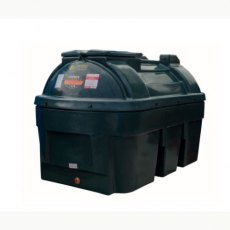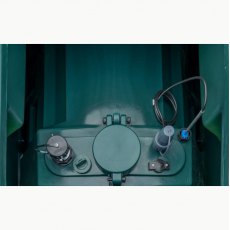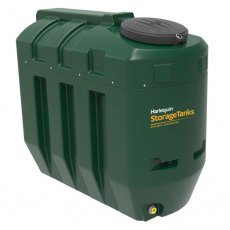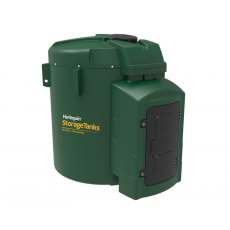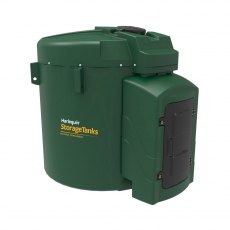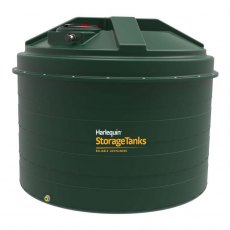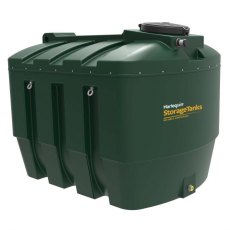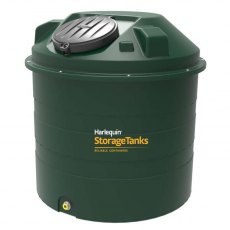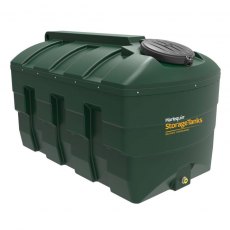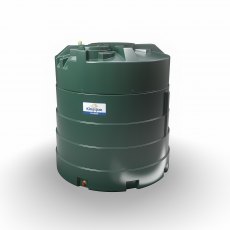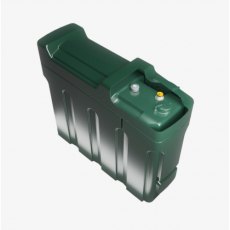Bunded Oil Tanks FAQs
Can you screen an oil tank?
Although Oil tanks are not the most attractive things to have in your garden, we always recommend seeking the advice of your local OFTEC registered liquid fuel tank installer as to the best place to position and how to screen your tank, if needed. The regulations for oil tank installation vary according to which region of the UK or Ireland you live in and there are also other environmental factors that need to be taken into account. For more information, please check out - OFTEC
Some ways customers have screened their tanks are below, however please check with your local OFTEC installer first.
Walls
One of the most common ways to hide an oil tank is to build a false wall around it. Whether you use bricks, stone or fencing, make sure you leave space to get in and around the tank for maintenance and replacement.
Landscaping
Probably the most effective and aesthetic ways to hide an oil tank is to surround it with shrubs, trees, or potted plants that can help to camouflage the tank from view. Make sure you the plants are properly maintained, as they can become a fire hazard if not cared for properly.
Whatever option you choose, your tank will be out of sight – but it should not remain out of mind! Remember to keep on top of oil levels and have your tank regularly inspected by a qualified engineer to prevent any potential problems.
What is a Single Skin Tank?
A single skin oil tank consists of a single container in which fuel is stored. Single skin oil tanks are not suitable for the storage of fuel at commercial, industrial or institutional premises; or at domestic installations with an installed capacity of over 2,500 litres - unless installed within a suitably bunded area. For all other installations, an Oil Tank Risk Assessment must be undertaken by a competent person prior to installation and in accordance with the requirements of OFTEC Technical Instruction Book 3. In anticipation of future possible regulations, serious consideration should be given to fitting a Bunded Tank, even where a single skin tank may currently suffice.
Click here to view our Single Skin Tanks
What is a Bunded Tank?
A Bunded Tank simply consists of an 'oil tank within an oil tank'. In the event of a spillage, surplus liquid will collect in the outer tank, thus averting a pollution incident. Bunded Tanks are now required at commercial, industrial, institutional, commercial and most domestic premises.
How close to a boundary can I place an oil storage tank?
If the oil tank has a nominal capacity of less than 3,500 litres, it should not be placed any closer than 760mm to a boundary. This assumes that there are no flue outlets or buildings between the tank and the boundary. Where these distances cannot be achieved, the protection measures noted in OFTEC Technical Instruction Book 3 and British Standard BS5410 must be provided by means of a 30-minute fire resistant wall which extends a minimum of 300mm above and beyond the ends of the oil tank. For oil tanks with a nominal capacity of 3,500 litres or greater please contact your local Building Control Officer or OFTEC.
How close to a flue outlet can I place an oil tank?
Oil tanks with a nominal capacity of less than 3,500 litres should not be placed within 1.8 metres of a flue outlet. Where these distances cannot be achieved, the protection measures noted in OFTEC Technical Instruction Book 3 and British Standard BS5410 must be provided by means of a 30-minute fire resistant wall which extends a minimum of 300mm above and beyond the ends of the tank. For oil tanks with a nominal capacity of 3,500 litres or greater please contact your local Building Control Officer or OFTEC.
How close to a building can I place an oil tank?
Oil tanks with a nominal capacity not exceeding 3,500 litres should not be fitted any closer than 1.8 metres to a non fire-rated (30-minute minimum fire resistance) wall or eaves. Where these clearances cannot be achieved, the measures noted in British Standard BS5410 and OFTEC Technical Instruction Book 3 must be provided i.e. the provision of a 30 minutes (minimum) fire resistant wall which extends at least 300mm above and beyond the ends of the oil tank. It will be necessary to protect exposed eaves forming part of a roof within 1.8 metres of the top of an oil tank to provide a minimum of 30 minutes fire resistance. Cladding can be applied to the eaves in order to prevent fire from spreading to the roof. For oil tanks with a capacity of 3,500 litres or greater, please contact your local Building Control Officer or OFTEC.
Can I place an oil tank inside a domestic garage or building?
Internal oil storage tanks should never be installed in a habitable area and if installed internally, should always be contained within an enclosed chamber. Detailed requirements exist for internal oil storage installations. For more information contact your local Building Control Officer or OFTEC.
Are any plastic oil tanks sold by Tanks.ie suitable for direct burial underground?
A definite NO.
From what materials are plastic oil tanks manufactured?
All oil tanks supplied by Tanks.ie are manufactured from Medium Density Polyethylene (MDPE) - a material that displays excellent chemical and impact resistance properties, making it ideal for external fuel storage. Fittings vary according to tank type and supplier. However, in general, fill points are made from either coated mild or stainless steel, outlets from coated mild steel, and vent points are manufactured from plastic. All materials used in the manufacture of oil tanks supplied by Tanks.ie are resistant to the potentially damaging long-term effects of fuel.
What are the base requirements for plastic oil tanks?
All oil tanks must be installed on a flat, level and fire resistant base capable of supporting the weight of the tank when fully laden. If concrete slabs are used they should be a minimum of 50mm thick. The base should extend at least 300mm beyond the widest points of the tank and fully support the base of the tank in its entirety. Piers or pillars are not suitable for this purpose and can cause irreparable damage to the tank.
Can I fit a sight-gauge to a single skin oil tank?
Technically, sight-gauges can still be fitted to a single skin oil tank - subject to prevailing statutory requirements. However, it should be noted that a sight-gauge is a potential leak point and as an environmentally responsible supplier we do not supply them and do not recommend them. Preference should instead be demonstrated to fitting an electronic oil tank contents gauge, which, unlike a sight gauge, is positioned above the maximum level of fuel in the tank, thereby dramatically reducing the likelihood of an environmental pollution incident. An Apollo type electronic oil tank gauging system is fitted as standard to all Harlequin Advance Single-Skin Oil tanks supplied by Tanks.ie - eliminating the requirement to fit a sight-gauge.
Can I fit a sight-gauge to a Bunded Tank?
No. Please note however that all Harlequin Bunded Tanks (except 350BND/ENV), Harlequin Polyrock Bunded Oil Tanks, Harlequin BioBund Bunded tanks, and Harlequin Fuel Stations are pre-supplied with an electronic oil tank contents gauge, which removes the requirement for a sight-gauge to be fitted.
There is a two-pin type socket fitted to my Harlequin oil tank. What is this for?
This permits an LRC enabled delivery driver to plug in his overfill prevention equipment and is not for consumer use.
Are plastic oil tanks designed to protect from the damaging effects of sunlight?
Yes. Every tank sold by Tanks.ie is manufactured from a material which incorporated UV inhibitors. These prevent UV rays from permeating the structure of the tank, thus preventing fuel degradation.
Are plastic oil tanks suitable for the storage of fuel for aviation use?
No.
Are plastic oil tanks fitted with sludge-valves / ball-cocks?
No. Openings (other than the tank outlet) are not permitted below the maximum level of fuel in the tank. This reduces the risk of accidental spillage. In the event that contaminants (e.g. water) need to be removed from the tank, they should be removed by an appropriately licensed contractor via the inspection aperture fitted to each tank.
I have discovered the presence of water in my oil. How do I get this removed?
Please contact your local fuel distributor who will be able to provide advice on how best to remove it.
Are plastic oil tanks suitable for use with oil fired cookers?
Yes.
On warm days there is a slight smell of oil from my oil tank. Why?
This is perfectly normal and is simply the fuel venting through the weatherproof vent fitted to the oil tank.
Do you sell gravity feed kits for the delivery of diesel fuel?
No, as an environmentally responsible supplier we do not supply these kits, due to the high risk of accidental damage / discharge associated with their use. Additionally, at many installations today their continued use is illegal. If you require a tank to store diesel fuel for vehicular use, we would advise you consider a Harlequin Fuel Station, or Fuel Point For BioDiesel applications, Harlequin BioFuel Stations are recommended for BioDiesel blends of up to B100. Alternatively, for connection to remote pedestal type dispensing units, Harlequin's BioBund range is ideal. Please note that all BioDiesel tanks supplied by Tanks.ie are suitable only for use with BioDiesel produced in accordance with European Standards.
Do you supply dip-sticks?
No - not as separate items. However, dipsticks are supplied as standard on all Harlequin tanks with a capacity between 650 litres and 2700 litres as standard.
Are Single Skin Oil Tanks or standard Bunded Tanks suitable for storing 'Adblue'?
No.

 Login
Login
